WHAT: A hike around the crater of Rano Kau, the biggest volcano of Easter Island + a visit to the ancient village of Orongo WHERE: Just outside the little town of Hanga Roa, a 15-minute drive from town HOW LONG: For the hike you need an hour or two. Add an extra 45 minutes for the visit to Orongo. HOW MUCH: To visit Orongo you need a ticket to the National Park, which gives you entrance to all of the highlights on the island. That ticket costs $80,- per person. I know it's expensive, but if you have come all the way to Easter Island ... you'll probably only be here once. The crater itself and the hike around it - which is even more spectacular than the petroglyphs of Orongo - is free! Funny enough.
All the way to its most southern tip, you can find the most beautiful caldera of Easter Island: Rano Kau. Calderas are always something special, but the one in here is just thrilling.
Rano Kau is the highest volcano of the island (of the total of 3) and luckily extinct since quite a long time. The last eruption also blew off the top of the cone, leaving room overtime for a deep freshwater lake, full of vegetation. As the crater rim has crumbled down a bit, you can have a stunning view from the mirador (viewing point of the crater) on the bright blue ocean right behind it.
The crater is arguably the most spectacular natural sight on the island and worth a couple of hours of your time. As the panoramas on both the island and the ocean are superb all around the crater, park your car at the mirador and prepare yourself for a small hike.
The path along the crater rim is easy to follow and not strenuous at all. Although that most likely depends on the brightness of the sun.
We hiked all the way to the outer left side of the crater and didn’t encounter anyone on the road. Just curious cows. One falcon. And a skittish cat for some reason. I hope this fellow made it safely back to the village.
Don’t try to walk all the way around the crater. That lower point in the middle is basically impossible to cross. There’s no sign of anything of where to stop walking, but with a bit of common sense you’ll just feel at what point you shouldn’t go any further. Also take care not to walk too far if the wind is strong, you don’t want to be blown over the crater rim into the ocean.
Just take a break before heading back and enjoy what nature has created over time at this remarkable spot.
It’s also possible to hike all the way up from Hanga Roa to the viewpoint of the crater (and back). But if you want to spare some energy I’d suggest you to drive to this mirador by car. The best views are to be seen from the highest point after all.
During the hike, from time to time you can see three small and rocky islands, located quite close to the volcano. Both are home to big colonies of seabirds. Locals refer to them as Motu Kao Kao, Motu Iti and Motu Nui.
In the heyday of the Rapa Nui culture these three drops in the ocean were very important, as the yearly so-called ‘birdman competition’ was held here. Young men from the clans on the island would swam to the islands (facing the brutal waves and sharks) and hide in the nooks and crannies for weeks awaiting the arrival of the Manutara – a specific seabird, the Sterna Fuscata-. The goal was to find its first egg.
The guy who was first would become the ‘birdman’ of the island, earn the king’s crown for one year (and with him his clan). Many procedures followed after his gain. His hair, eyelashes and eyebrows were shaved, he had to tour around the island and remain in either Rano Raraku or at Anakena on his own (accompanied by a priest) for a whole year, until the next ceremony began. But it would give him the ultimate 17th century celebrity status. The Justin Bieber of his time.
If you want to learn more about the competition, head over to the small museum on the western side of the crater. Boards with information and a small maquette explain the history of the birdman ceremonies, the life in the villages and how the people of Rapa Nui lived before the first western explorers came in sight in 1722.
After soaking up all of the information, it’s an easy stroll around the ancient village of Orongo next to the museum. This was were the ceremonial part of the birdman contest took place. It’s small, but interesting to see how the people of Rapa Nui used to live.
One of the ‘houses’ – that are all partially integrated in the ground – has been cracked open to give a better view of the small scale of the house. The most interesting part of this area however might be the petroglyphs, depictions of birdman included.
Within 30 minutes you can see it all.
From the outer spot of this place you can have another view on the crater. But honestly, the best views on the crater itself are from the other side.
We returned a second time to the crater to see the sunrise in here. It was amazing to see the rays warming up the entire island. And there was just nobody around at 8 am.
Except the cows once again of course.
So if you go, try to start early in the morning. Watch the sunrise, next do the hike (Orongo won’t be opened already) and watch the petroglyphs in the end! Or return a second time. Not a bad idea either.








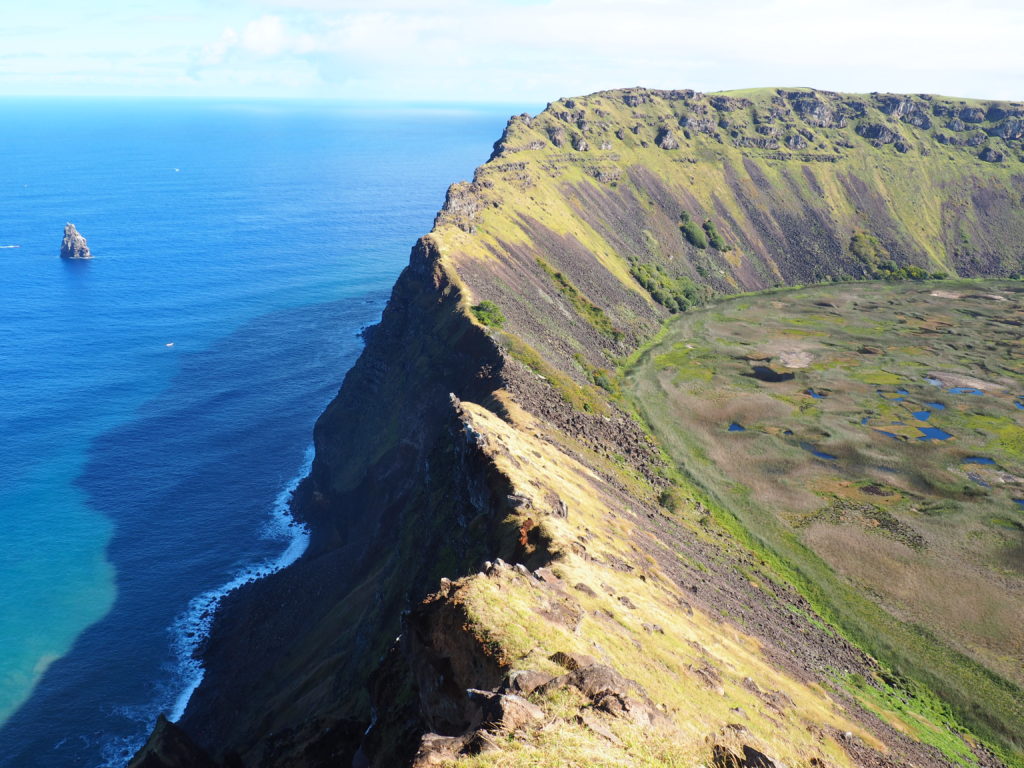


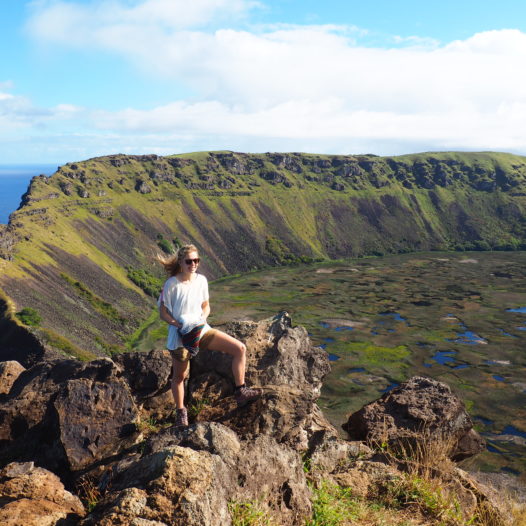














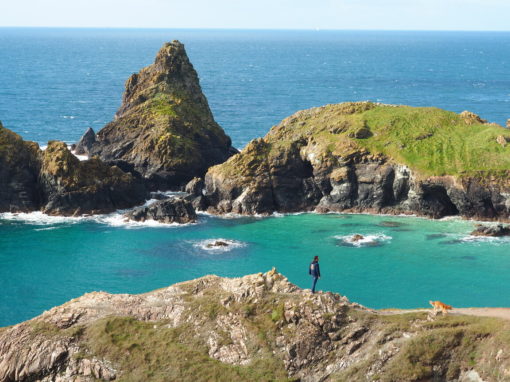
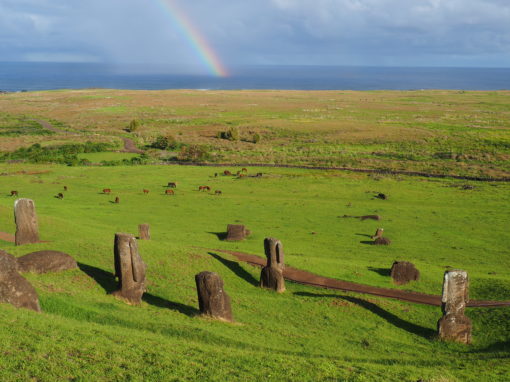
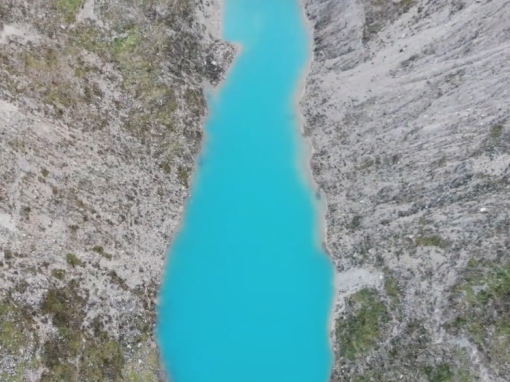

Dominic
October 31, 2019 at 11:20 am
Can you hike down into the crater by yourself or with a guide? It looks amazing!
Kristel
November 1, 2019 at 5:08 am
Hi Dominic, thanks for your message. No I don’t think that’s allowed – it’s also quite steep! However, the views along the crater are cool enough by itself! Best wishes, Kristel
Kimberly
March 21, 2020 at 11:38 pm
Hey Kristel.
Curious if the hike is light enough for us to take our toddler with us (on a carrier, of course). Trying to figure if we should take him with us, or just leave him with my mum and dad at the hotel. Would love to experience this with him, but safety comes first!
Kristel
March 22, 2020 at 6:28 am
Hi Kimberly! Great that you are (still) going to Easter Island. Hope all will be well over there regarding the circumstances. Yes I actually do think the walk would be feasible with a toddler in a carrier. The road is relatively flat and not that long and you can always return whenever you’re getting tired! Just wear sturdy shoes. The views are all around anyway. So I’d say.. give it a go! Enjoy your trip! Best, Kristel from TTT